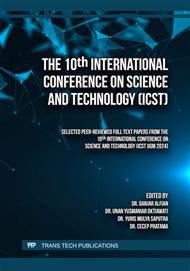[1]
R. Khatibi, L. Naghipour, M.A. Ghorbani, M.T. Aalami, Predictability of relative humidity by two artificial intelligence techniques using noisy data from two Californian gauging stations, Neural Comput. Appl. 23 (2013) 2241-2252.
DOI: 10.1007/s00521-012-1175-z
Google Scholar
[2]
L.N. Gunawardhana, G.A. Al-Rawas, S. Kazama, An alternative method for predicting relative humidity for climate change studies, Meteorol. Appl. 24 (2017) 551-559.
DOI: 10.1002/met.1641
Google Scholar
[3]
M. Adnan, R.M. Adnan, S. Liu, M. Saifullah, Y. Latif, M. Iqbal, Prediction of relative humidity in a high elevated basin of western Karakoram by using different machine learning models, in: Weather Forecasting, IntechOpen, 2021.
DOI: 10.5772/intechopen.98226
Google Scholar
[4]
A.S. Abobakr Yahya, A.N. Ahmed, F.B. Othman, R.K. Ibrahim, H.A. Afan, A. El-Shafie, C.M. Fai, M.S. Hossain, M. Ehteram, A. Elshafie, Water quality prediction model based on support vector machine model for ungauged river catchment under dual scenarios, Water (Basel) 11 (2019) 1231.
DOI: 10.3390/w11061231
Google Scholar
[5]
M. Shad, Y.D. Sharma, A. Singh, Forecasting of monthly relative humidity in Delhi, India, using SARIMA and ANN models, Model Earth Syst. Environ. 8 (2022) 4843-4851.
DOI: 10.1007/s40808-022-01385-8
Google Scholar
[6]
S. Pinthong, P. Ditthakit, N. Salaeh, M.A. Hasan, C.T. Son, N.T.T. Linh, S. Islam, K.K. Yadav, Imputation of missing monthly rainfall data using machine learning and spatial interpolation approaches in Thale Sap Songkhla River Basin, Thailand, Environ. Sci. Pollut. Res. (2022).
DOI: 10.1007/s11356-022-23022-8
Google Scholar
[7]
E.R. Coutinho, R.M. da Silva, J.G.F. Madeira, P.R. de O.S. Coutinho, R.A.M. Boloy, A.R.S. Delgado, Application of artificial neural networks (ANNs) in the gap filling of meteorological time series, Rev. Bras. Meteorol. 33 (2018) 317-328.
DOI: 10.1590/0102-7786332013
Google Scholar
[8]
E. Dyukarev, Comparison of artificial neural network and regression models for filling temporal gaps of meteorological variables time series, Appl. Sci. 13 (2023) 2646.
DOI: 10.3390/app13042646
Google Scholar
[9]
A. Ali Slieman, D. Kozlov, Estimation and filling of missing runoff data at Al-Jawadiyah station using artificial neural networks, E3S Web Conf. 263 (2021) 05034.
DOI: 10.1051/e3sconf/202126305034
Google Scholar
[10]
M. Addi, Y. Gyasi-Agyei, E. Obuobie, L.K. Amekudzi, Evaluation of imputation techniques for infilling missing daily rainfall records on river basins in Ghana, Hydrol. Sci. J. 67 (2022) 613-627.
DOI: 10.1080/02626667.2022.2030868
Google Scholar
[11]
A. Aieb, K. Madani, M. Scarpa, B. Bonaccorso, K. Lefsih, K.A. Lefsih, A new approach for processing climate missing databases applied to daily rainfall data in Soummam watershed, Algeria, Heliyon 5 (2019) 1247.
DOI: 10.1016/j.heliyon.2019.e01247
Google Scholar
[12]
M. Dash, H. Liu, Feature selection for classification, Intell. Data Anal. 1 (1997) 131-156.
Google Scholar
[13]
M. Negnevitsky, Artificial Intelligence: A Guide to Intelligent Systems, Pearson Education, 2005.
Google Scholar
[14]
P. Refaeilzadeh, L. Tang, H. Liu, Cross-validation, in: Encyclopedia of Database Systems, Springer US, Boston, MA, 2009, pp.532-538.
DOI: 10.1007/978-0-387-39940-9_565
Google Scholar
[15]
J. Sarwono, Metode Penelitian Kuantitatif dan Kualitatif, Suluh Media, 2018.
Google Scholar
[16]
P. Subagyo, Forecasting: Konsep dan Aplikasi, BPFE-UGM, 2009.
Google Scholar
[17]
N.A.A. Norazizi, S.M. Deni, Comparison of artificial neural network (ANN) and other imputation methods in estimating missing rainfall data at Kuantan station, in (2019) 298-306.
DOI: 10.1007/978-981-15-0399-3_24
Google Scholar
[18]
J. Das Agrawal, ANN in forecasting missing rainfall data, E3S Web Conf. 405 (2023) 04017.
DOI: 10.1051/e3sconf/202340504017
Google Scholar
[19]
S.-L. Shen, N. Zhang, A. Zhou, Z.-Y. Yin, Enhancement of neural networks with an alternative activation function tanhLU, Expert Syst. Appl. 199 (2022) 117181.
DOI: 10.1016/j.eswa.2022.117181
Google Scholar


